The 1930s women’s fashion was elegant, glamorous, attractive, and overall more feminine than the previous decade. In the 1930s, the world’s economy took a significant hit. This period of economic downturn is known as the great depression. The great depression affected the economy of both rich and developing countries. It started with the United States and then influenced other nation’s prosperity as well. The timings of the great depression varied from country to state. It was the most widespread economic downfall of the 20th century.
Because of the great depression, 1930s fashion does not get as much spotlight as it deserves. Though the whole world’s economy was going downhill, the 1930s brought glamour and style to its trend. The 1930s continued to raise the bar for fashion started earlier in the 20th century. During the 1930s, women’s fashion grew immensely. Women’s dresses, clothing, shoes, and all the other fashion trends saw significant changes from the 1920s.
1930s women’s fashion
The 1930s women’s fashion changed all the fashion trends of the 1920s. Many people think that the 1920s women’s fashion was kind of boyish and not feminine enough. During the 1920s, women’s dresses had a loose squared shape. The dresses followed drop-waist and high knee-length hem design. These design patterns were entirely gone during the first half of the 1930s.
In the 1930s, the dresses regained their form-fitting style of the late 19th century. Their dresses had a high neckline, high waistline, and fitted hips. The length of their dresses was at least calf-length or, in some cases, floor-length. The dresses had some trims and wide shoulders. Many people say that 1930s women’s clothing was well-tailored, modest, and more feminine.
Ideal Women’s Body
At that time, women’s ideal body shape changed completely. Earlier, women strived for a narrow waist and wide hips. But in this decade, a women’s perfect body shape was a tall, slender body with a small waist and narrow hips. But most women did not have this body shape. So, this problem was solved with the design of their clothing. Most of the 1930s women’s dresses had a full shoulder. This helped the women to achieve their ideal shape and made their waist and hip look smaller.
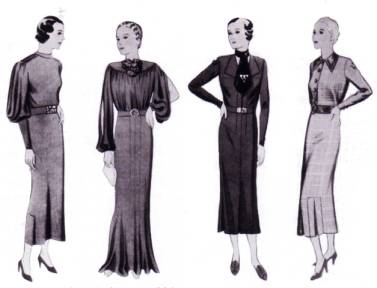
Women’s Dresses
At the beginning of this decade, many women preferred to make their dresses. This helped them to minimize the cost. But during the great depression, the price of the fabric and buttons went up. The cost of zippers became less than the button. Factory-made dresses could be mass-produced. They cost way less than the custom-made dresses. That is why factory-made dresses became more popular.
Most women preferred less expensive fabric for their dresses. During this time, women wore dresses made from rough fabric and cotton. The rough texture became a trend in 1930s women’s fashion. In the 1930s, women had a lot of options when it comes to their dresses. There were quite a few dress patterns in that era. All kinds of 1930s women’s dresses are different from each other in some shape or form.
Dresses for Home
Women’s home dresses were simple. They wore these dresses when they are in front of their family or during visiting the neighborhoods. These dresses were basic cotton dresses. The design of the dresses followed the ideal dress design of a narrow waist and hip. There were different kinds of necklines for women’s dresses. The common ones are shallow v-neck, squared, and small scoops. The collar was usually trimmed with white ruffles. Like the neckline, there were a lot of choices for the sleeves too. Women’s dresses had sleeve styles like square, puff, ruffles, flutters, and so on. The house dresses had large armholes for more natural hand movements.
One of the more memorable home dresses during the 1930s is the “hooverette.” It was a cheap, more practical and, washable dress. It had a shallow V-neck and shawl collar. The neckline was trimmed with ruffles. The dress had ruffle sleeves. It has an accentuated tie waist and a slim cut through the hips.
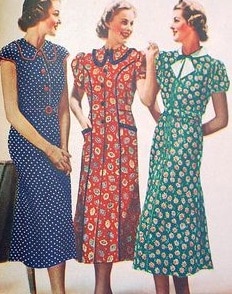
Most women preferred to make their home dresses. They used various exciting ways to make their home dresses. Some sew the dresses by themselves. Some made newer dresses and frocks from their old existing dresses. Some even made dresses and aprons from fabrics from grocery bags. Most of their clothing had some sort of bright print.
Day Dresses
1930s women’s day dresses or afternoon dresses were much different from the cotton housedresses. These day dresses were called city or town tailored dresses. Women did not wear house dresses when they went out of the home. Women always prefer great day dresses over the housedress when they are out for shopping, errands, or other reasons.
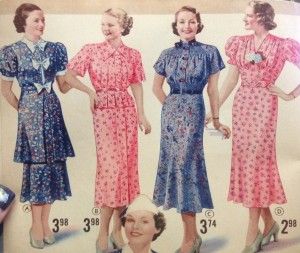
Instead of cotton, these day dresses were made from silk or rayon crepe. The shape of the dress followed the ideal form of the 1930s. These dresses were more decorated than house dresses. These dresses had a lot more embroidery, decorative buttons, and faux flower trimmings. Most of the time, day dresses had puff sleeves, a belted waist, and large yokes and collar. The color choices for day dresses were solid color or subdued prints. Most dresses had a belt slightly over the middle waist. The color of the belt matched the color of the dresses.
Evening Dresses
The evening dress for women during the 1930s is the most beautiful and glamourous thing from that era. These evening dresses looked expensive and classy. They were different from day dresses and home dresses. These evening dresses were silky and clung to the women’s bodies. Women ofter wore these dresses with a fur wrap or coats.
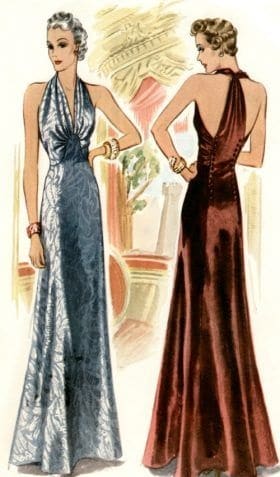
The fabric choice for these dresses was also different. Some of the popular fabrics for evening gowns were silk, chiffon, and satin. These fabrics were cut in a way so that the dress had an elegant flowing line. The hems of the dress were floor length. Some dresses had a small train in the back.
The evening dress also followed the ideal silhouette of the 1930s dresses. The dresses had a very slim fit. The dresses were fitted through the waist and hips and ease out above the knee. From the knee, the dresses flared elegantly to the floor. Earlier in the 1930s, these dresses had puffs and ruffle sleeves. But later, high neck and halter styles with plunging back become popular. The backless dress design was widespread in the 1930s evening dresses.
The evening dresses of the 1930s have made their way in modern fashion. Most people still think that these dresses make women more feminine and elegant. Nowadays, you will see many celebrities wear 1930s inspired dresses on the red carpet.
Wedding Dresses
The Wedding Dresses of the 1930s has some similarity with the evening dress. The bottom half of the dress had a similar look from the front. But the similarity stopped there. The wedding dresses had a much distinct look because of their color and design.
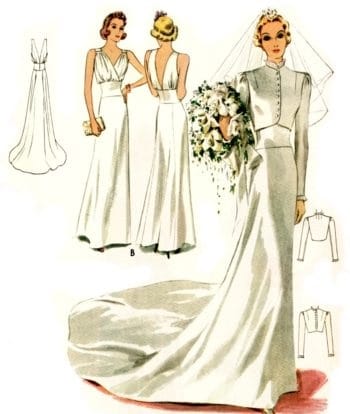
The 1930s wedding dress was a bias-cut dress. The neckline of the dresses was pretty high. These dresses had long sleeves. The dress was tighter in the waist and hip. But it flared way from the thigh. The wedding dresses were floor-length gowns. They featured a fishtail train made from silk or satin.
Check this article to know about 1930s wedding dresses in detail.
Other Clothing
The 1930s offered a lot of different types of cloth to women. Most of us think that, in the old days, women only wore dresses. But that is not true at all. Like modern times, women also wore clothing like coats, blouses, pants, and skirts. Though the design was much different, the types of apparel were pretty much the same.
Coats
In the 1930s, there were a few types of coats for women. Some of the standard coats are winter coats, raincoats, and jackets. The coat was pretty long. They went to the calf length. These coats had full shoulders and puffed sleeves. The coats had a nipped high waist. The collar was oversized and made out of wool. Some coats had a detachable fur collar. Most of the coats buttoned up from the front. Some had buttons in the middle, and some had buttons in off-center. Some coats featured a matching belt. The common colors for the winter coats were green, medium blue, wine, and cream.
The raincoats followed the similar design of the winter coats. Among various type of raincoats, the trench coat, and the cape coat was popular. Most of the raincoats had a rubber coating or made entirely from rubber. This rubber texture allowed the raincoat to repel rainwater easily. In the 1930s, transparent raincoats also became trendy. Many women prefer bright raincoats over regular raincoats.
The casual jacket also became popular among many women. Some women wore these casual jackets with skirts and blouses. The jackets looked like a blazer made of wool. These jackets had a single or double-breasted front. They were available in both solid colors and patterns. Another common type of casual jacket was the Cossack style jacket. These jackets had a similar design to a man’s jacket. The jackets were made from wool, leather, and artificial leather. The military-style jacket was also popular with some women. Many women loved these short men’s jackets and even bought those for themselves.
Blouses
In the 1930s, blouses were popular with many women. They wore blouses with pants and skirts. Women liked blouses for their simplicity. The most simple blouses were button-down cotton blouses. Some blouses had a floral print. The blouses were short, and the length was a little under the pants and the skirts. The necklines were high and had small collars. If the blouses had a low neckline, women would cover it with a scarf tied around the neck. The silk or knit scarf was tucked under the blouse. The blouses were decorated with pintucks, ruffles, and contrasting buttons. These gave the blouses a very womanly design.
Women wore blouses as casual and formal dress. Most of the time, women wore white blouses with button-down front and classic point collars. Aside from white, other popular patterns were plaid, stripes, and polka dots. Sometimes, printed blouses were sold with a matching jacket.
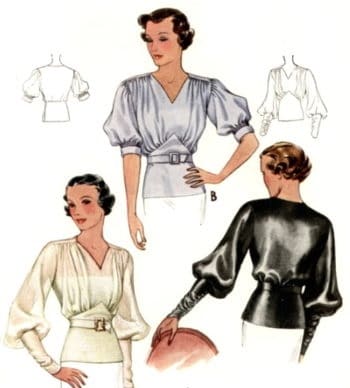
Sweaters
Sweaters were also worn by many women during the 1930s. Some women liked to wear a knit top with pants. Some of these high knits had a polo shirt like collars and ties. Others had t-shirt like round necklines. Some top knits even had zippers.
Pullover sweaters and cardigans were also in style. These sweaters had a slim fit. So it gave women the narrow waist look. They had both short and long sleeves. The necklines were high. The sweater with long sleeves was fitted down to the wrist. These sweaters were worn on their own or over a blouse. Some sweaters had simple decorations like ribbon flowers and contrasting buttons.
Pants
In the previous decade, pants for women were not accepted socially. But in the 1930s, pants became more accepted than in the earlier decades. Most pants for women were wide-legged trousers. They had a crease in the front. If women were not moving, the pants sometimes looked like a skirt. Some pants had a double button front. Others had buttons or zippers on the side. These pants used fabrics like cotton for summer and wool for winter.
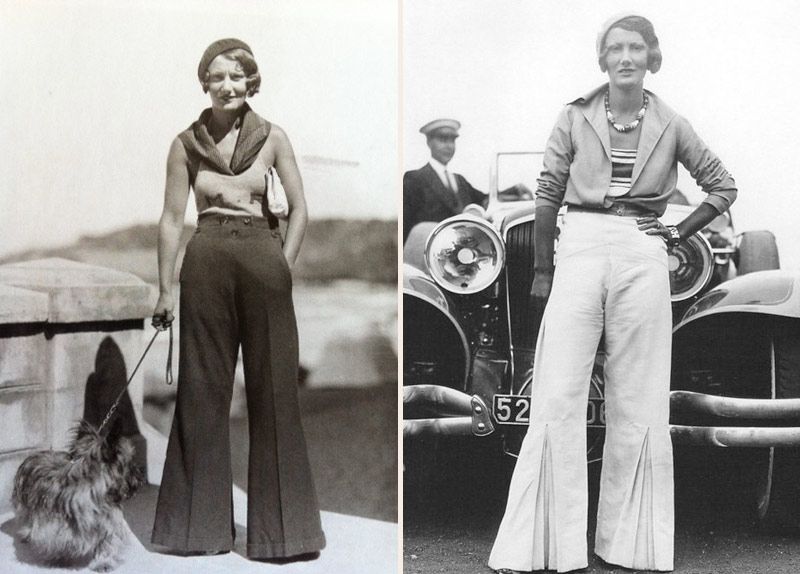
Skirts
A good alternative for pants was a well-tailored skirt. During the early 1930s, the length of the skirts was almost ankle length. In the middle of the decade, ruffle skirts were replaced by long column skirts. The skirt’s design and length continued to change throughout the decade. The skirt gradually transitioned into a flared-up design. The length got shorten from the mid-calf length to just below the knee. At the end of the decade, the skirt had a high waist, a slim fit, and a flare at the bottom.
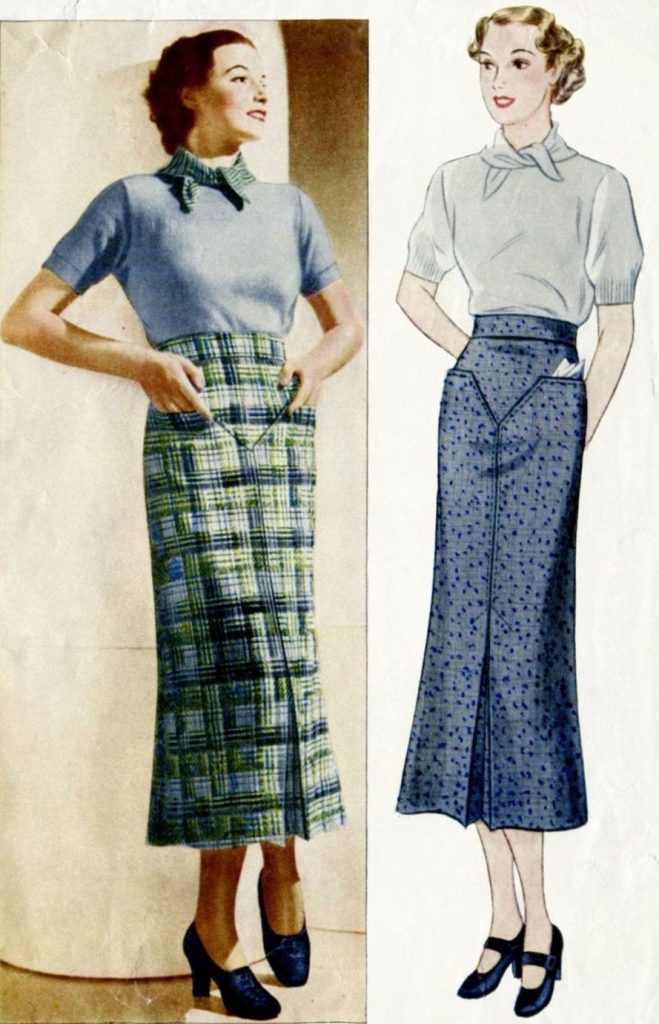
Swimwear
In the 1930s, tanning became popular with many women. This trend was popularized with 1930s Hollywood. Women with tanned bodies were thought to have time for leisure. This decade’s women’s swimwear was much different by today. Women had a few choices when it comes to swimwear.
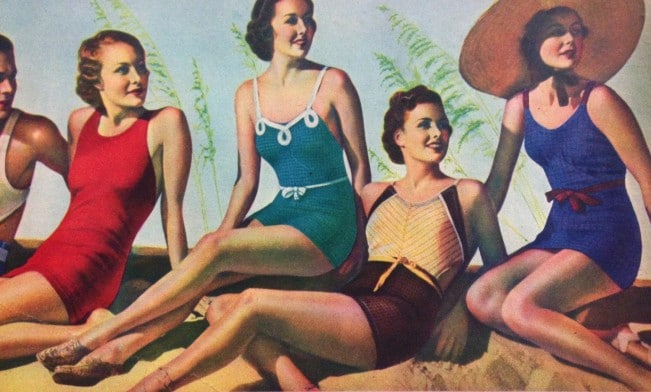
Some women wore fitted one-piece swimwear made out of wool. This kind of swimwear had a cotton jersey lining. Some women wore a mini skirt over a boy’s shorts. Another popular swimwears were beach pajamas. The looked like a modern palazzo and was broader than that time’s women’s pant. Those pants were very comfortable and liked by many women.
Fashion Accessories for women in the 1930s
The 1930s women’s fashion trends did not limit themselves to clothing only. Women were also interested In other accessories that would complement their overall look. During the time of the 1930s economic downfall, women understand that a little accessory can make a simple dress look astonishing. So, they did not hesitate to buy a few accessories despite having a tight budget. If a woman could manage the right dress and food for the family, she got respected by her peers. These kinds of women were considered valuable assets to her husband and family. Women’s in the 1930s used a wide variety of accessories. Among them, hats, bags & purses, gloves, and jewelry were ubiquitous.
Hats
The main reason for wearing a hat was to make the women more elegant. There were a few types of hats available in this decade. The beret made its way to the 1930s from the previous decade. The 1920s cloche evolved itself into a slouch hat. These slouch hats had a wide brim. The hat was worn low on the face and turned up on the forehead. Some women also wear small hats. These hats were dressed in a tilt. Sometimes they had a single feather on it.
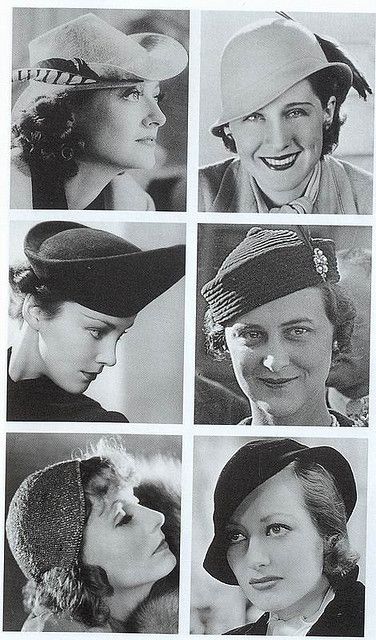
Other popular types of hats were small white straw hats. They were worn during the summer or on the beach. Some women also wore wide-brimmed hats. These wide-brimmed hats were known as cartwheel hats.
Bags
Handbags and purses became an essential part of women’s fashion during the 1930s. The simple envelope bag or clutches from the 1920s also made their way to the 1930s. These bags had a rectangular shape. The material of the bag was smooth and polished.

The purse grew in size during this decade. This allowed women to carry more objects than before. The handbags had multiple hidden compartments for jewelry. By 1933, many bags used magnetic clasps to close up the bag. Zippers are also used in some packs. Zipper made opening and closing handbags much easier.
The favored material for 1930s women’s bags was leather. Aside from that, some women used bags with animal skin. The homemade bags were made from crocheted yarn, woven straw, wood beads, and sewn fabrics.
Gloves
Some women wore gloves with their dresses. Gloves were not that common like other accessories. Women usually wore gloves with their day dresses and evening dresses. There a few varieties of gloves used by women. With day dresses, women wore gauntlet-style mid-arm length gloves. Those gloves used crochet lace or soft leather. These gloves had flaring cuffs at the wrist or turned-over cuffs with embroideries. Some women wore elbow-length with their evening gowns. But most of them preferred bare arms with evening dresses.
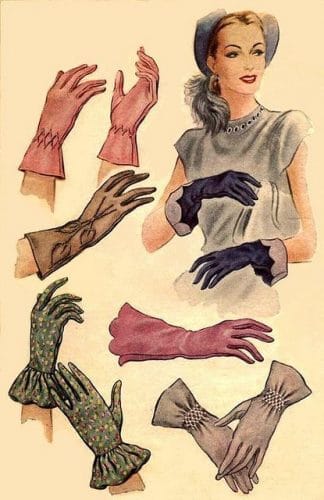
Jewelry
Women considered jewelry as an essential accessory during the 1930s. The jewelry price depended on the stone used on it. The pearls were expensive. Not all women had the budget to buy them. So, colored glass beads took the place of the gem. Also, they were very cheap compared to the pearl. Another famous stone for jewelry was rhinestones. They were cheap and shiny. So these stones were used in dress clips, earrings, necklaces, and bracelets. The design of the jewelry went back to Victorian-style jewelry.
Women’s Shoes during the 1930s
During the 1930s, women had a wide variety of shoes to choose from. The most popular shoes were walking Oxford shoes. There were also other styles of shoes during that time. Shoes like pumps, T-straps, low heel flats, sandals, and ankle-straps were available everywhere. The pumps had square heels. The boots had lacing, removable tongue, and topstitching. The t-strap shoes wear worn with casual dresses. The dancing sandal was popular with evening dresses. It was a high heel with straps. Standard colors for shoes were black and brown in winter and white in the summer.
Women’s Beauty Trends & Makeup
1930s women’s fashion saw a lot of changes. Short hair became more trendy. Women visit the saloon quite often to cut and curl their hair. Most of them wash their hair once a week and used heat to curl their hair.
The makeup style also changed quite a bit from earlier. Women tried to get a light complexion with a pink undertone. They used white or ivory-tinted powder over a layer of cream. Their eyebrows were thin and arched. Eyeline pencil was available during the 1930s. Women used eyeliner on the upper and lower lids of their eyes. The lips were painted with a soft pink tone. This complemented the pinkish blush on their cheeks.
Here you can find the details about 1930s makeup.
Color and Fabric choice
There was a limited color option for 1930s women’s fashion. During spring and summer, the typical colors for women were peach, yellow, sky blue, sea green, and rose pink. The winter cloth had colors like grey, tan, brown, rust, navy blue, and black. Aside from this, colors like red, orange, blue, and mustard were used all year round.
Conclusion
In the 1930s, women’s fashion was full of glamour and elegance. But the women’s style did not overindulge itself with glamour. Most of the women’s cloth in this era were practical and comfortable. Women’s clothing in that decade was aesthetic and charming overall.

